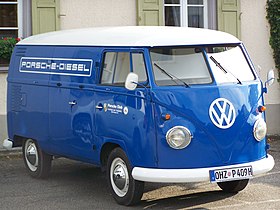It has been suggested that this article be split into a new article titled Talk:Volkswagen_Type_2#Divide-unbundle_the_first_and_second_generations_page. (discuss) (April 2024) |
| Volkswagen Type 2 | |
|---|---|
 | |
| Overview | |
| Manufacturer | Volkswagen |
| Also called |
|
| Production | November 1949[1] – present |
| Body and chassis | |
| Class | Light commercial vehicle (M) |
| Body style | |
| Layout |
|
| Platform | Volkswagen Group T platform |
| Chronology | |
| Successor | Volkswagen ID. Buzz (Type 2 RWD) |
The Volkswagen Transporter, initially the Type 2,[2] is a range of light commercial vehicles, built both as vans, pickups, and cab and chassis variants, introduced in 1950 by the German automaker Volkswagen as their second mass production light motor vehicle series, and inspired by an idea and request from then Netherlands VW importer Ben Pon.
Known officially (depending on body type) as the Transporter, Kombi or Microbus[citation needed] – or informally as the Volkswagen Station Wagon[3] (US), Bus[3] (also US), Camper (UK) or Bulli (Germany), it was initially given the factory designation 'Type 2', as it followed – and was for decades based on – the original 'Volkswagen' ("People's Car"), which became the VW factory's 'Type 1' after the post-war reboot, and mostly known, in many languages, as the "Beetle".[4]
The Volkswagen Transporter has been built in many variants, maybe best known for its panel vans, but also built as a small bus or minivan, with choices of up to 23 windows, and choice of either hinged or sliding side doors. From the first generation, both regular and crew-cab, as well as long and short-bed pickups were made, and multiple firms sprang up, to manufacture varying designs of camper vans, based on VW's Transporter models, to this day.
For the first 40 years, all VW Type 2 variants were forward control, with a VW Beetle derived flat-four engine in the rear, and all riding on the same (initial thirty years – T1 and T2), or similar (T3),[5] 2.40 m (94 in) wheelbase as the Type 1 Beetle. As a result, all forward-control Type 2 pickups were either standard cab, long-bed or crew-cab, short-bed configuration, and because of the relatively high bed-floor (above the rear, flat engine), most pickups came with drop-sides in addition to the tailgate. In 1979, the 3rd generation Type 2 introduced an all new, more square and boxy body, and in the 1980s also introduced a raised four-wheel drive bus variant.
From the introduction of the fourth generation Transporter in 1990, the vehicle layout changed to a more common front-engined one – no longer forward-control – and also changed from rear- to front-wheel drive, with 4WD remaining optional. From then on, the platform no longer shared technological legacy with the Beetle, and Volkswagen just called them 'Transporter', and no longer 'Type 2'. The new models, though growing a bit in length, got a significantly longer wheelbase, that pushed the wheels closer to the truck's corners, and noticeably reduced its front and rear overhangs: and extended wheelbase models were also introduced.
- ^ Cite error: The named reference
Walters, p.46was invoked but never defined (see the help page). - ^ Volkswagen definitively dropped the 'Type 2' designation for the Transporters after the third of six generations.
- ^ a b Murilee Martin (15 April 2019). "1966: Early Volkswagen Bus makes a great restaurant". Autoweek. Retrieved 27 November 2023.
- ^ "History of the Volkswagen bus". Brinse.com. Archived from the original on 10 August 2011. Retrieved 19 August 2011.
- ^ The Transporter T3 of the 1980s, introduced in 1979, had a marginally longer wheelbase, but continued the same pattern for another decade.